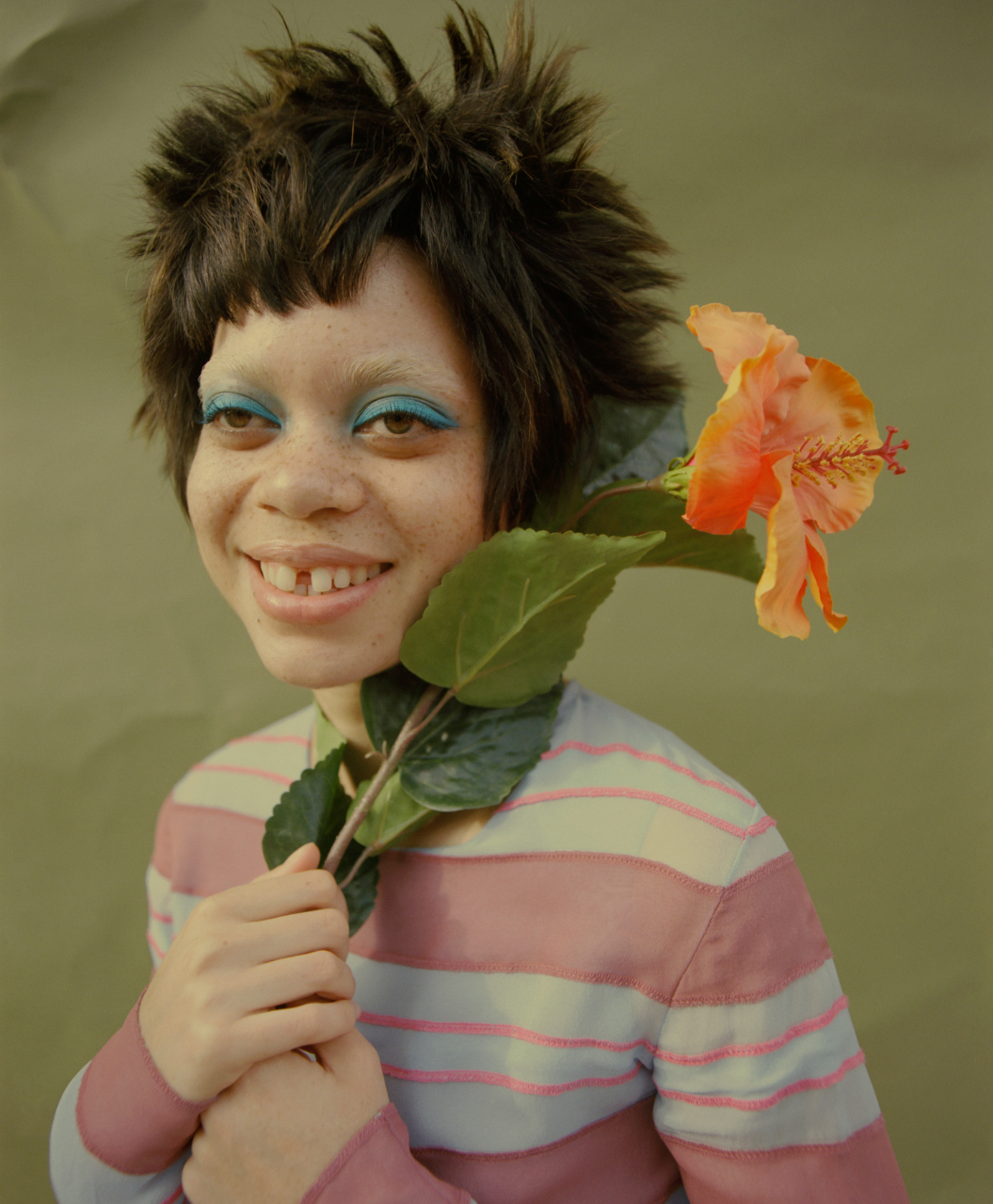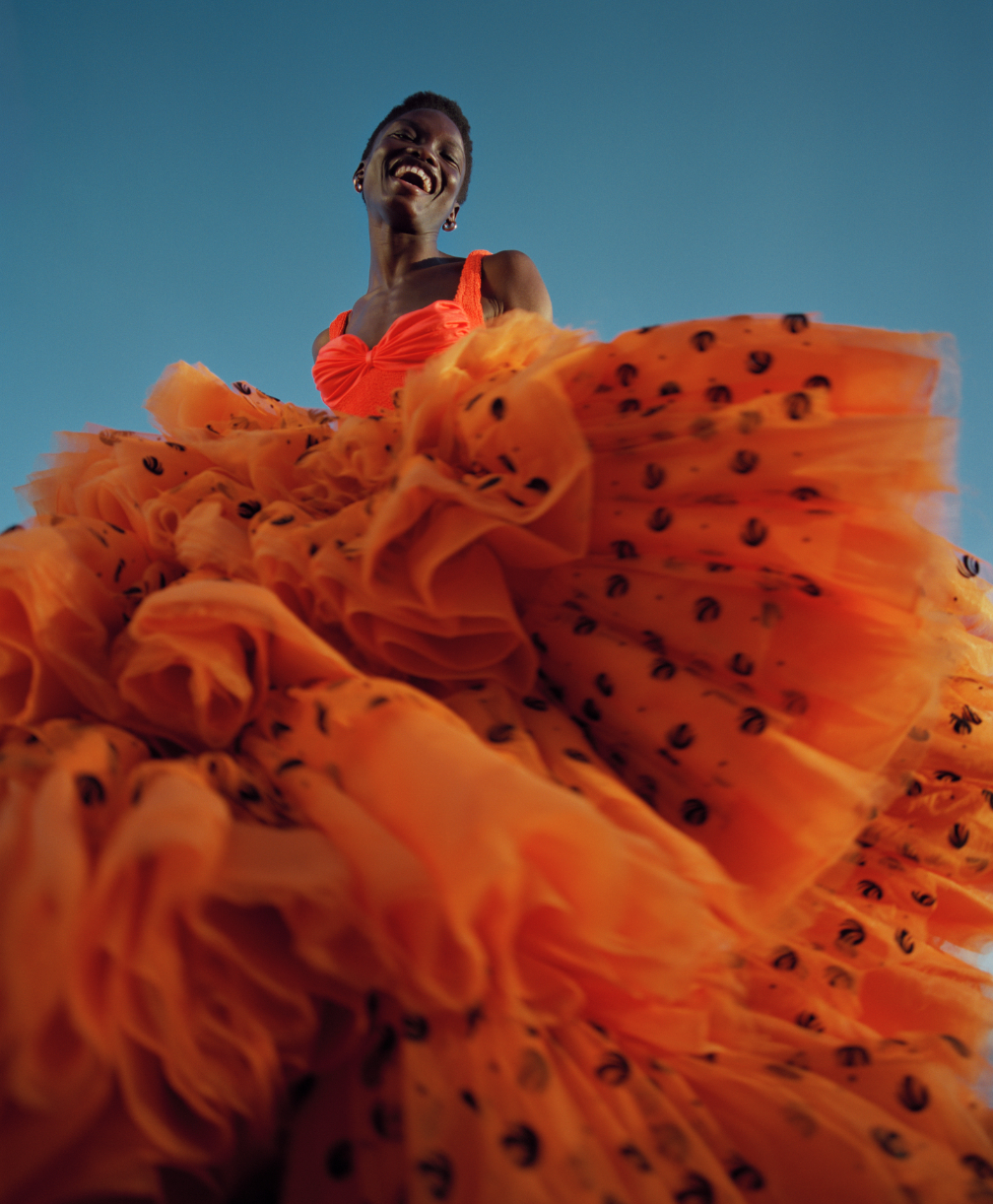Photographer Nadine Ijewere knows all about a “beautiful disruption.’ As the first Black woman to have ever shot an American and British Vogue cover, the 28-year-old British artist of Nigerian and Jamaican descent has consistently pushed boundaries with her work that sets to upend preconceived beauty ideals, and in an industry obsessed by the perfection of youth, seeks value in what lies in imperfection. “My work is about showcasing different forms of beauty that I believe our society could do a better job of representing,” Ijewere explains. “We are so different, and I think it is especially important to show this in the world of fashion. I follow this principle when I cast models and also by exploring my own origins.” Now Ijewere sets her eyes upon photography gallery C/O Berlin for Beautiful Disruption, her first exhibition amassing roughly 80 images and three films where the visual world she’s created, often filled with striking colors and intertwined embraces, stands on full salute. With a fresh lockdown in Berlin now over, we spoke via email with the barrier-breaking photographer on her newest venture, how milestones can be converted into lasting change, and to find out what can be beautiful in an era of disruption.
C/O Berlin will present Nadine Ijewere’s Beautiful Disruption from its reopening May 29th to September 2nd at the Amerika Haus, Hardenbergstraße 22- 24, 10623 Berlin.

Courtesy of C/O Berlin
What is the meaning behind the name of your upcoming exhibition “Beautiful Disruption” and are there any works here that haven’t been shown before?
I photograph beautiful black people, beautiful black families, beautiful people of colour from many different backgrounds. My work has been penetrating an industry that for so long has shut us out. This to me is a beautiful disruption. One day I hope this will no longer be seen as a “disruption”. For black people to be present why must something have to be disturbed? Instead of kicking down doors, one would hope the doors won’t exist in the future, we will all just be welcome. This exhibition is somewhat of a timeline of my work so far, all of which have been shown before.
As the first black woman to have ever shot an American and British Vogue cover, how can the industry effectively tackle inclusivity both behind and in front of the lens? How does being the first hold significance for you?
An effective way of tackling this is not having a couple of token people tick the inclusivity box. While it is amazing to finally have inclusivity in the industry, there are many different talented people of colour that have different stories to tell, we need to hear what they have to say too.
The inclusivity of women in the industry is also something that needs a much closer look at. The industry has been male-dominated for so long and continues to be even to this day. Which has always surprised me because women make up a majority of fashion consumers.
Being the first black woman to shoot both an American and British Vogue cover means a lot to me because I know that somewhere it will encourage a young black girl to pick up a camera. When you don’t see people like yourself in places doing things, it’s much harder to believe that it’s possible to be in those places doing things.

Courtesy of C/O Berlin
You’ve relentlessly defied traditional beauty standards & societal norms in your work by casting your own models. What do you look for when casting muses?
For such a long time there was less than a handful of black models for black girls to look up to. Even then the beauty standards were made to conform to European ideals. When casting muses I aim to celebrate their natural beauty. Black girls have always been made to feel that their hair is not beautiful, not acceptable. I beg to differ. Black hair is beautiful, in all of its many different shapes, forms, and styles. I want all people of colour to be seen within the industry and celebrated.
How do collaborators like Gabriella Karefa-Johnson aid your creative process?
I met Gabriella in 2018, she reached out to me via CLM to collaborate on a Garage Magazine story. Our first story together was very special, immediately we bounced ideas off each other. Working with a fellow woman of colour inspired me creatively. When we work together we both have a level of comfort where we can be transparent. It’s essentially two friends coming together to create something beautiful. Generally, when I collaborate with people I try to reach a level of comfort where I can be transparent, this way nothing is blocking my creative process. It’s marriage, if you are both transparent, even if there is a difference in the vision you can find the perfect middle ground.
How was the experience going through your archives during this past pandemic year?
The pandemic has been very testing. Community is so important to me, not being able to be around my people has been hard. However, from every negative scenario, I try to draw positivity. One thing this year has allowed me to do is slow down and look back at my works. Generally, I am busy shooting and planning I don’t have much time to go through the archives. Looking through some of my old shoots filled me with love and warmth throughout the pandemic. Remembering the personalities of the models and how we laughed together. Remembering all of the people we met in-between. Also looking at shoots and remembering some of the battles that had to be overcome. Every story I shoot has a separate story behind it.

Courtesy of C/O Berlin
When looking through the Material Values images for the exhibition it reminded me of the rules of life. Imagine being in Jamaica at the most beautiful location, the weather is perfect, the models are ready, hair, makeup, and styling look absolutely amazing, everyone’s energy is incredible. All of a sudden like a flick of a light switch the sky goes from sunny blue to black and stormy. It’s literally a thunderstorm, so we have to retreat to the bus and wait it out. The weather isn’t giving at all, time is running out and we have a lot to shoot. The mood did drop, I even cried, but together as a team we uplifted each other and we started to drive around the island chasing good weather. It took time but we found some better weather and got some more shots done. The next day we got up extra early to make the most of a clear morning it needed up being a great last day. Despite all of the disruptions the shoot turned out to be beautiful.
What first drove you to photography?
I was actually going to study medicine and took photography as an A-level alongside the scientific subjects. The course for me was my first step into it. Being completely analog which I think was rare in a very digital world. I was introduced to the darkroom, printing, and film cameras besides the pharmacy throwaway kind. I loved the process and I suppose I had always loved photographing people, so it landed me in the area I am in today.
Your imagery often includes vivid color, glam beauty, and soft, mostly natural light. What connects you to these themes and are you showcasing cultural identity, in any way?
I think I have always been drawn to colour in imagery for me when I celebrate beauty. I want there to be a sense of vibrance and energy and natural light has felt for me the best way to convey this.

Courtesy of C/O Berlin
Last year’s Family Values American Vogue editorial was an ode to the beauty of Black women and African designers. As someone with Jamaican & Nigerian heritage, what was your personal connection to the references & how was the energy on set?
The connection was of that which was being celebrated-the strong, independent, and unapologetic women in my family and in my culture that I had grown up with, the one who tells you about what looks good and gives unsolicited advice about your love life. These are real women and I wanted their stories to be told especially in spaces like Vogue which you don’t really see, it touches again with the themes within my work beauty seen in different ways. The energies were uplifting and celebratory too which was so nice considering what’s happening in the world we were excited to tell part of our stories.
What do you want audiences to feel when they see your images?
I want people to realise that beauty comes in many different shades, shapes and forms. I shoot people of all different backgrounds, for we are all beautiful and important. I want people to have a positive feeling when they see my work. There is too much division in the world, I want people to look at my work and feel connected. To feel the love of community.



